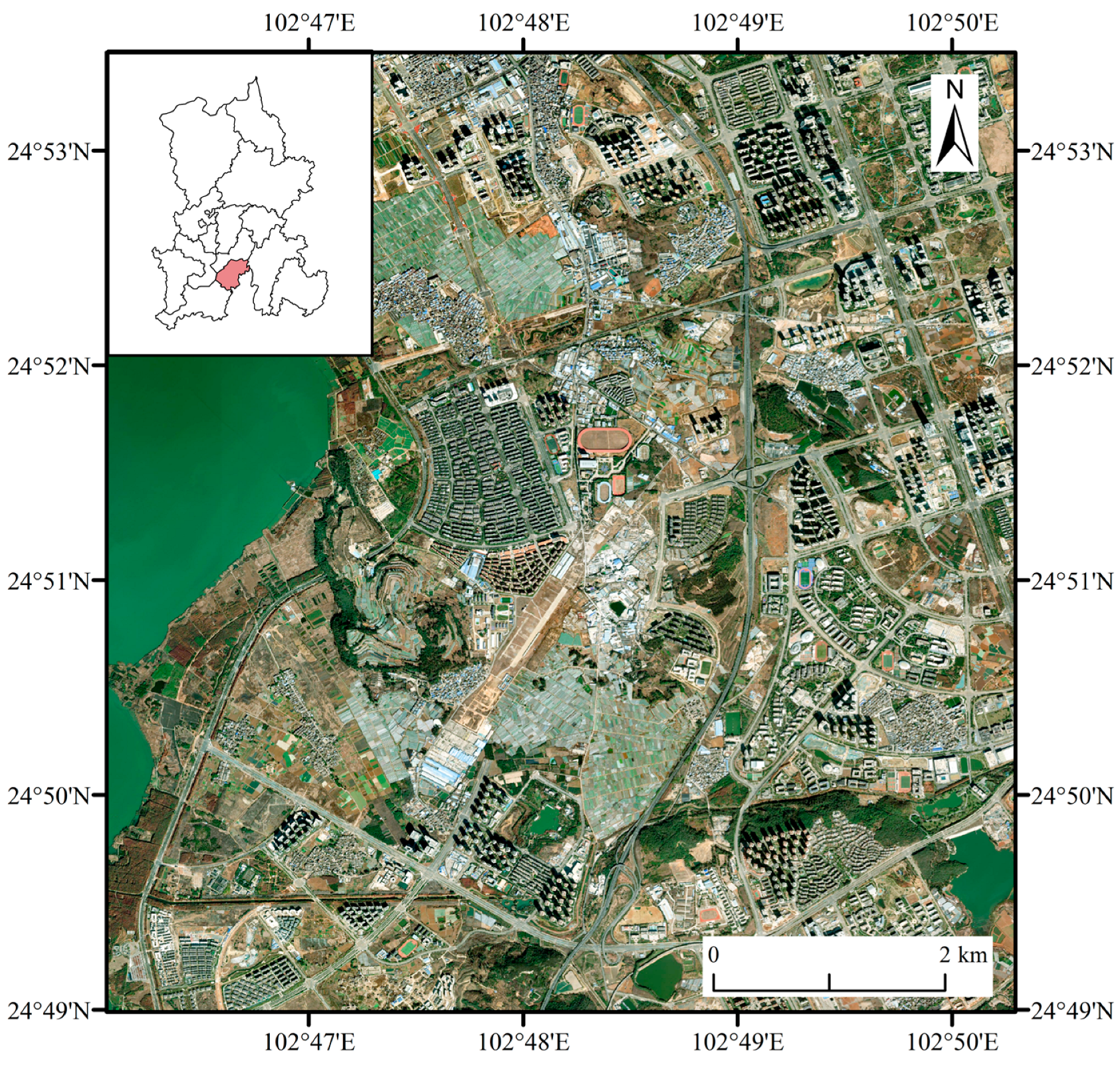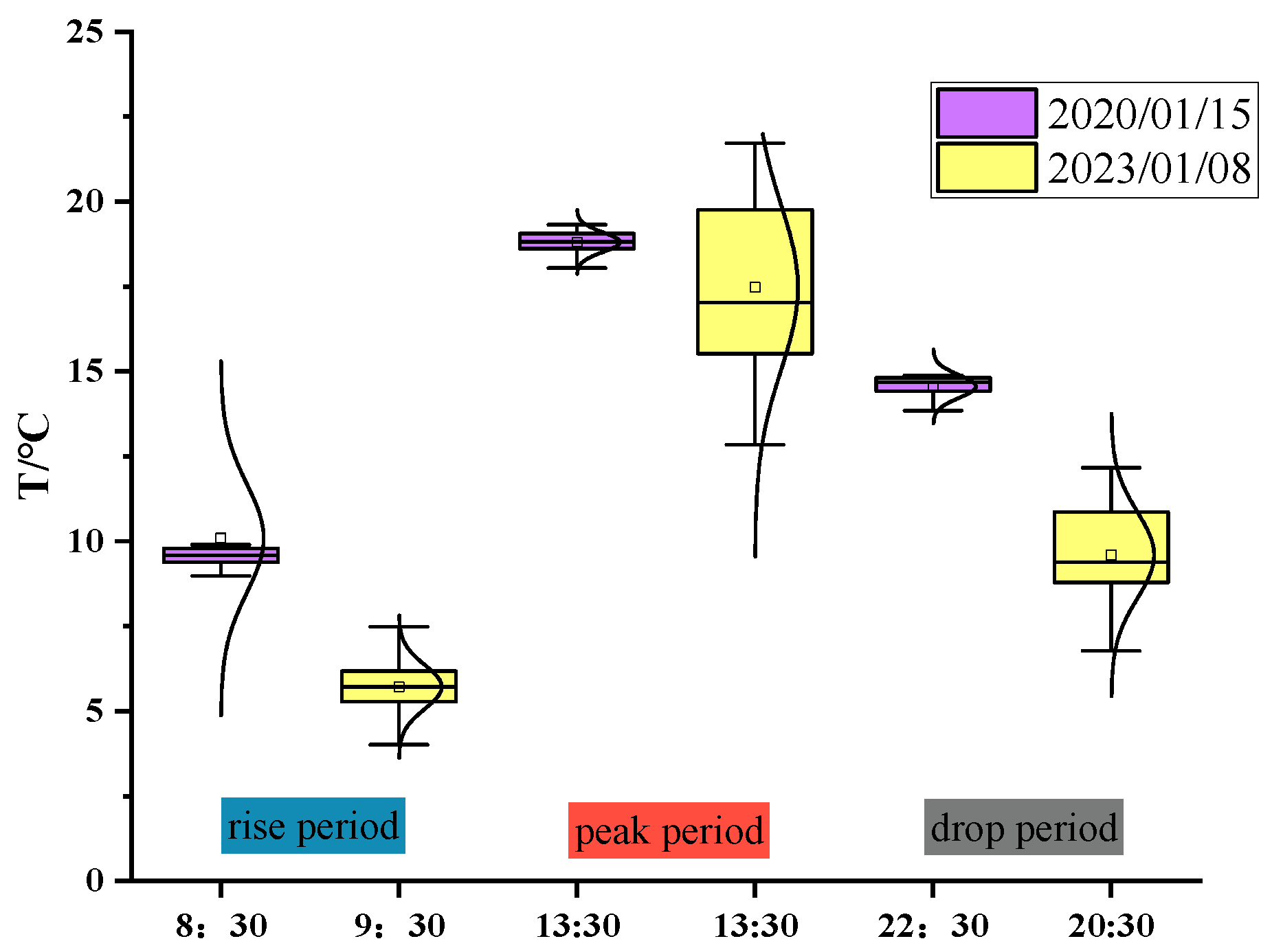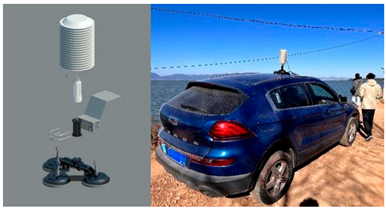Thermal Environment Analysis of Kunming’s Micro-Scale Area Based on Mobile Observation Data
Abstract
1. Introduction
2. Materials and Methods
2.1. Study Area
2.2. Data Collection
2.2.1. Weather Station Data
2.2.2. Mobile Observation Data
2.3. Data Processing
2.3.1. Data Processing of Raw Data
- Temperature Data
- 2.
- GPS Data
2.3.2. Data Normalization
- Aligning Timestamps
- 2.
- Spatial Interpolation
- 3.
- Simultaneous Revision
2.3.3. Creating Contour Maps
2.4. Calculating the Fluctuation in Urban Thermal Environment
3. Results
3.1. Distribution of the Thermal Environment
3.2. Fluctuations in the Thermal Environment
4. Discussion
4.1. Distribution of Thermal Environment at Different Times in the Study Area
4.2. Impact of Different Urban Functional Areas on the Thermal Environment
4.3. Research Limitations and Future Directions
5. Conclusions
- As the temperature declines, the urban thermal environment undergoes significant changes, leading to a reduction in the area of the urban heat islands and an increase in urban cold islands.
- In response to the temperature drop, different urban functional areas exhibit varying thermal feedback, with industrial and residential areas being more sensitive to temperature changes, resulting in a distribution characterized by lower temperatures.
- Temperature fluctuations in the study area have intensified; the maximum standard deviation of the 2020 test data did not exceed 0.35 °C with a temperature difference of less than 1.5 °C, whereas the standard deviation of the 2023 data increased significantly across all three periods, reaching up to 2.43 °C, and the temperature difference expanded to 7.5 °C. This indicates that the thermal environment fluctuations in the study area are significant.
Author Contributions
Funding
Data Availability Statement
Conflicts of Interest
References
- Oke, T.R. The energetic basis of the urban heat island. Q. J. R. Meteorol. Soc. 1982, 108, 1–24. [Google Scholar] [CrossRef]
- Broitman, D.; Koomen, E. Residential density change: Densification and urban expansion. Comput. Environ. Urban Syst. 2015, 54, 32–46. [Google Scholar] [CrossRef]
- Gao, Y.; Zhang, N.; Chen, Y.; Luo, L.; Ao, X.; Li, W. Urban heat island characteristics of Yangtze river delta in a heatwave month of 2017. Meteorol. Atmos. Phys. 2024, 136, 30. [Google Scholar] [CrossRef]
- Anjileli, H.; Huning, L.S.; Moftakhari, H.; Ashraf, S.; Asanjan, A.A.; Norouzi, H.; AghaKouchak, A. Extreme heat events heighten soil respiration. Sci. Rep. 2021, 11, 6632. [Google Scholar] [CrossRef] [PubMed]
- Oleson, K. Contrasts between Urban and Rural Climate in CCSM4 CMIP5 Climate Change Scenarios. J. Clim. 2012, 25, 1390–1412. [Google Scholar] [CrossRef]
- Brusseleers, L.; Nguyen, V.G.; Vu, K.C.; Dung, H.H.; Somers, B.; Verbist, B. Assessment of the impact of local climate zones on fine dust concentrations: A case study from Hanoi. Vietnam Build. Environ. 2023, 242, 110430. [Google Scholar] [CrossRef]
- Xi, Y.; Wang, S.; Zou, Y.; Zhou, X.; Zhang, Y. Seasonal surface urban heat island analysis based on local climate zones. Ecol. Indic. 2024, 159, 111669. [Google Scholar] [CrossRef]
- Ornam, K.; Wonorahardjo, S.; Triyadi, S. Several façade types for mitigating urban heat island intensity. Build. Environ. 2024, 248, 111031. [Google Scholar] [CrossRef]
- Zhao, J.; Zhao, X.; Liang, S.; Zhou, T.; Du, X.; Xu, P.; Wu, D. Assessing the thermal contributions of urban land cover types. Landsc. Urban. Plan. 2020, 204, 103927. [Google Scholar] [CrossRef]
- Shen, P.; Wang, M.; Liu, J.; Ji, Y. Hourly air temperature projection in future urban area by coupling climate change and urban heat island effect. Energy Build. 2023, 279, 112676. [Google Scholar] [CrossRef]
- Lin, Z.; Xu, H.; Yao, X.; Yang, C.; Ye, D. How does urban thermal environmental factors impact diurnal cycle of land surface temperature? A multi-dimensional and multi-granularity perspective. Sustain. Cities Soc. 2024, 101, 105190. [Google Scholar] [CrossRef]
- Stewart, I.D.; Oke, T. Local Climate Zones for Urban Temperature Studies. Bull. Am. Meteorol. Soc. 2012, 93, 1879–1900. [Google Scholar] [CrossRef]
- Tao, H.; Xing, J.; Pan, G.; Pleim, J.; Ran, L.; Wang, S.; Chang, X.; Li, G.; Chen, F.; Li, J. Impact of anthropogenic heat emissions on meteorological parameters and air quality in Beijing using a high-resolution model simulation. Front. Environ. Sci. Eng. 2022, 16, 44. [Google Scholar] [CrossRef]
- Núñez, A.; García, A.M.; Moreno, D.A.; Guantes, R. Seasonal changes dominate long-term variability of the urban air microbiome across space and time. Environ. Int. 2021, 150, 106423. [Google Scholar] [CrossRef]
- Klompmaker, J.O.; Hart, J.E.; James, P.; Sabath, M.B.; Wu, X.; Zanobetti, A.; Dominici, F.; Laden, F. Air pollution and cardiovascular disease hospitalization—Are associations modified by greenness, temperature and humidity? Environ. Int. 2021, 156, 106715. [Google Scholar] [CrossRef]
- Wu, R.; Guo, Q.; Fan, J.; Guo, C.; Wang, G.; Wu, W.; Xu, J. Association between air pollution and outpatient visits for allergic rhinitis: Effect modification by ambient temperature and relative humidity. Sci. Total Environ. 2022, 821, 152960. [Google Scholar] [CrossRef]
- Fang, W.; Li, Z.; Gao, J.; Meng, R.; He, G.; Hou, Z.; Zhu, S.; Zhou, M.; Zhou, C.; Xiao, Y.; et al. The joint and interaction effect of high temperature and humidity on mortality in China. Environ. Int. 2023, 171, 107669. [Google Scholar] [CrossRef]
- Shu, C.; Gaur, A.; Wang, L.; Lacasse, M.A. Evolution of the local climate in Montreal and Ottawa before, during and after a heatwave and the effects on urban heat islands. Sci. Total Environ. 2023, 890, 164497. [Google Scholar] [CrossRef]
- Zhu, Z.; Shen, Y.; Fu, W.; Zheng, D.; Huang, P.; Li, J.; Lan, Y.; Chen, Z.; Liu, Q.; Xu, X.; et al. How does 2D and 3D of urban morphology affect the seasonal land surface temperature in Island City? A block-scale perspective. Ecol. Indic. 2023, 150, 110221. [Google Scholar] [CrossRef] [PubMed]
- Zhou, L.; Yuan, B.; Hu, F.; Wei, C.; Dang, X.; Sun, D. Understanding the effects of 2D/3D urban morphology on land surface temperature based on local climate zones. Build. Environ. 2022, 208, 108578. [Google Scholar] [CrossRef]
- Das, M.; Das, A. Assessing the relationship between local climatic zones (LCZs) and land surface temperature (LST)—A case study of Sriniketan-Santiniketan Planning Area (SSPA), West Bengal, India. Urban Clim. 2020, 32, 100591. [Google Scholar] [CrossRef]
- Han, Y.; Qiao, D.; Zhang, Y.; Wang, J. Urban expansion dynamic and its potential effects on dry-wet circumstances in China’s national-level agricultural districts. Sci. Total Environ. 2022, 853, 158386. [Google Scholar] [CrossRef]
- Yuan, B.; Zhou, L.; Hu, F.; Zhang, Q. Diurnal dynamics of heat exposure in Xi’an: A perspective from local climate zone. Build. Environ. 2022, 222, 109400. [Google Scholar] [CrossRef]
- Wang, R.; Voogt, J.; Ren, C.; Ng, E. Spatial-temporal variations of surface urban heat island: An application of local climate zone into large Chinese cities. Build. Environ. 2022, 222, 109378. [Google Scholar] [CrossRef]
- Acosta, M.P.; Vahdatikhaki, F.; Santos, J.; Jarro, S.P.; Dorée, A.G. Data-driven analysis of Urban Heat Island phenomenon based on street typology. Sustain. Cities Soc. 2024, 101, 105170. [Google Scholar] [CrossRef]
- Kawakubo, S.; Arata, S.; Demizu, Y.; Kamata, T.; Narumi, D.; Asawa, T.; Ihara, T. Visualization of urban roadway surface temperature by applying deep learning to infrared images from mobile measurements. Sustain. Cities Soc. 2023, 99, 104991. [Google Scholar] [CrossRef]
- Li, X.S.; Chen, H.; Han, M.T.; Cao, J.Y. Research on the Temperature Gradients Change from Wuhan Urban Center to Suburb in Summer. Appl. Mech. Mater. 2012, 174–177, 3598–3602. [Google Scholar] [CrossRef]
- Kim, S.W.; Brown, R.D. Development of a micro-scale heat island (MHI) model to assess the thermal environment in urban street canyons. Renew. Sustain. Energy Rev. 2023, 184, 113598. [Google Scholar] [CrossRef]
- Zhang, Y.; Du, X.; Shi, Y. Effects of street canyon design on pedestrian thermal comfort in the hot-humid area of China. Int J Biometeorol. 2017, 61, 1421–1432. [Google Scholar] [CrossRef]
- Chang, Y.; Xiao, J.; Li, X.; Weng, Q. Monitoring diurnal dynamics of surface urban heat island for urban agglomerations using ECOSTRESS land surface temperature observations. Sustain. Cities Soc. 2023, 98, 104833. [Google Scholar] [CrossRef]
- Hao, L.; Huang, X.; Qin, M.; Liu, Y.; Li, W.; Sun, G. Ecohydrological Processes Explain Urban Dry Island Effects in a Wet Region, Southern China. Water Resour. Res. 2018, 54, 6757–6771. [Google Scholar] [CrossRef]
- Gunawardena, K.R.; Wells, M.J.; Kershaw, T. Utilising green and bluespace to mitigate urban heat island intensity. Sci. Total Environ. 2017, 584–585, 1040–1055. [Google Scholar] [CrossRef]
- Geng, S.; Yang, L.; Sun, Z.; Wang, Z.; Qian, J.; Jiang, C.; Wen, M. Spatiotemporal patterns and driving forces of remotely sensed urban agglomeration heat islands in South China. Sci. Total Environ. 2021, 800, 149499. [Google Scholar] [CrossRef]





| Equipment | Modes | Legends | Specifications |
|---|---|---|---|
| Professional GPS Data Logger/United States of America/Onset Computer Corporation Company | Columbus P-1 |  | The positioning accuracy of the GPS is 1.5 m (horizontal) at 50% CEP (circular error probable) and 4.0 m at 95% CEP. |
| Temperature/RH Data Logger/Canada/Canada GPS Company | Onset MX2302A |  | This device has a temperature range of −40 °C to 70 °C, with measurement accuracies of ±0.25 °C below freezing and ±0.2 °C above, and a fine resolution of 0.04 °C. |
| Vehicle-mounted mobile measurement device |  | / | |
| Test Date | Tmin/°C | Tmax/°C | ΔT/°C | MATmax/°C | MATmin/°C |
|---|---|---|---|---|---|
| 15 January 2020 8 January 2023 | 9 3 | 19 16 | 10 13 | 19 16 | 10 13 |
| Test Date | Testing Time | Tmax/°C | Tmin/°C | ΔT/°C | σT/°C |
|---|---|---|---|---|---|
| 15 January 2020 | 08:30 15:30 20:30 | 9.9 19.3 14.9 | 8.9 18.0 13.7 | 1.0 1.3 1.2 | 0.24 0.29 0.34 |
| 8 January 2023 | 09:30 15:30 20:30 | 7.8 20.5 12.4 | 4.0 13.0 8.0 | 3.8 7.5 4.4 | 0.60 2.43 1.28 |
Disclaimer/Publisher’s Note: The statements, opinions and data contained in all publications are solely those of the individual author(s) and contributor(s) and not of MDPI and/or the editor(s). MDPI and/or the editor(s) disclaim responsibility for any injury to people or property resulting from any ideas, methods, instructions or products referred to in the content. |
© 2025 by the authors. Licensee MDPI, Basel, Switzerland. This article is an open access article distributed under the terms and conditions of the Creative Commons Attribution (CC BY) license (https://creativecommons.org/licenses/by/4.0/).
Share and Cite
Zhu, P.; Ma, Z.; Ou, C.; Wang, Z. Thermal Environment Analysis of Kunming’s Micro-Scale Area Based on Mobile Observation Data. Buildings 2025, 15, 2517. https://doi.org/10.3390/buildings15142517
Zhu P, Ma Z, Ou C, Wang Z. Thermal Environment Analysis of Kunming’s Micro-Scale Area Based on Mobile Observation Data. Buildings. 2025; 15(14):2517. https://doi.org/10.3390/buildings15142517
Chicago/Turabian StyleZhu, Pengkun, Ziyang Ma, Cuiyun Ou, and Zhihao Wang. 2025. "Thermal Environment Analysis of Kunming’s Micro-Scale Area Based on Mobile Observation Data" Buildings 15, no. 14: 2517. https://doi.org/10.3390/buildings15142517
APA StyleZhu, P., Ma, Z., Ou, C., & Wang, Z. (2025). Thermal Environment Analysis of Kunming’s Micro-Scale Area Based on Mobile Observation Data. Buildings, 15(14), 2517. https://doi.org/10.3390/buildings15142517






